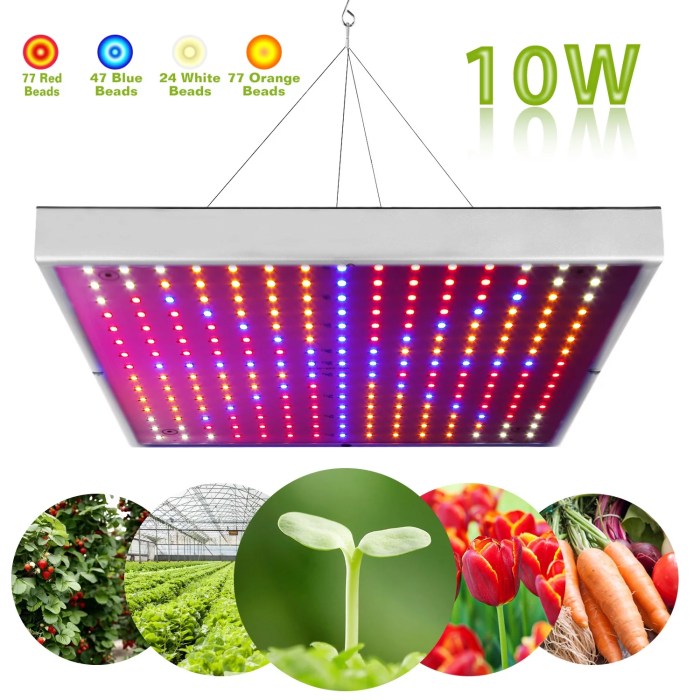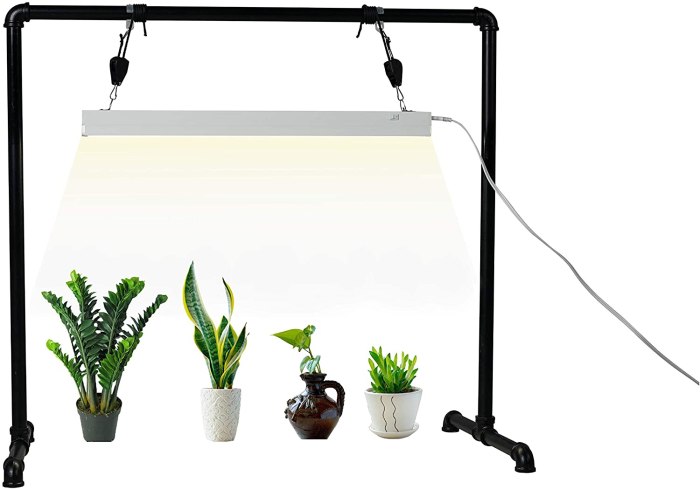Hanging plant grow lights are an innovative solution for thriving indoor plants, offering a tailored lighting experience to enhance their growth and well-being. This comprehensive guide delves into the intricacies of choosing, installing, and maintaining hanging grow lights, empowering you to create an optimal environment for your beloved greenery.
From understanding the spectrum of light to troubleshooting common issues, this guide equips you with the knowledge and techniques to maximize the benefits of hanging plant grow lights. Whether you’re a seasoned plant enthusiast or just starting your indoor gardening journey, this guide will illuminate the path to vibrant, flourishing plants.
Popular Types of Hanging Plant Grow Lights
Hanging plant grow lights provide essential illumination for indoor plants, promoting their growth and health. Various types of grow lights are available, each with unique characteristics and benefits.
The most popular types of hanging plant grow lights include:
LED Grow Lights
- LED (light-emitting diode) grow lights are energy-efficient and long-lasting, with a lifespan of up to 50,000 hours.
- They produce a targeted spectrum of light that can be customized to suit specific plant needs.
- LED grow lights are relatively expensive but offer high efficiency and versatility.
Fluorescent Grow Lights, Hanging plant grow light
- Fluorescent grow lights are a cost-effective option and are widely available.
- They emit a broad spectrum of light, making them suitable for a variety of plants.
- However, fluorescent grow lights have a shorter lifespan than LED lights and require frequent replacement.
Incandescent Grow Lights
- Incandescent grow lights are the least expensive option but also the least efficient.
- They produce a warm, reddish light that is not ideal for plant growth.
- Incandescent grow lights have a short lifespan and generate a lot of heat, which can damage plants.
The ideal spectrum of light for hanging plants depends on the specific plant species. However, most plants require a combination of blue and red light for optimal growth.
Factors to Consider When Choosing a Hanging Plant Grow Light

Choosing the right hanging plant grow light is essential for the health and growth of your indoor plants. Here are some key factors to consider when making your selection:
Light Intensity
Light intensity is measured in foot-candles (fc) or lux (lx). The higher the light intensity, the brighter the light. For most indoor plants, a light intensity of 1000-2000 fc is ideal. You can measure light intensity using a light meter or a smartphone app.
Coverage Area
The coverage area of a grow light is the area that it can effectively illuminate. To calculate the coverage area, multiply the length of the grow light by its width. For example, a grow light that is 2 feet long and 1 foot wide has a coverage area of 2 square feet.
For indoor plant enthusiasts, hanging plant light is a must-have. These specialized lights provide the optimal illumination for hanging plants, ensuring healthy growth and vibrant foliage. Hanging plant light mimics natural sunlight, promoting photosynthesis and preventing leggy, stretched growth. Whether you’re a seasoned plant parent or just starting out, hanging plant grow light can elevate your indoor gardening experience.
Adjustable Grow Lights
Adjustable grow lights allow you to change the height of the light and the intensity of the light. This can be useful for plants that require different light levels at different stages of growth.
Adjustable grow lights are more expensive than non-adjustable grow lights, but they offer more flexibility and control over the lighting environment.
Installation and Placement of Hanging Plant Grow Lights
Installing and positioning hanging plant grow lights properly is crucial for optimal plant growth and health. Here’s a step-by-step guide and essential considerations:
Step-by-Step Installation
- Determine the location:Choose a spot where plants will receive ample natural light and can be easily accessed for watering and maintenance.
- Suspend the light:Hang the grow light from a ceiling hook or bracket using the provided chains or cords. Ensure it’s level and secure.
- Adjust the height:Position the light at an appropriate height, considering the plant species and growth stage. Generally, keep the light 12-24 inches above the plant canopy.
- Plug in the light:Connect the grow light to a power outlet and turn it on.
Optimal Height and Distance
The optimal height and distance of the grow light depend on the plant species, growth stage, and light intensity. As a general rule:
- Seedlings and young plants:Keep the light 12-18 inches above the plant canopy.
- Mature plants:Position the light 18-24 inches above the plant canopy.
- High-intensity lights:Maintain a greater distance to prevent scorching.
Maximizing Light Coverage
To maximize light coverage and minimize shadows:
- Use multiple lights:Consider using multiple smaller lights instead of a single large one to distribute light evenly.
- Reflectors:Install reflectors around the grow light to redirect light towards the plants.
- Rotate plants:Periodically rotate plants to ensure all sides receive adequate light.
Troubleshooting Common Issues with Hanging Plant Grow Lights
Hanging plant grow lights can enhance plant growth and well-being, but they can also encounter problems. Identifying and resolving these issues promptly ensures optimal light conditions for your plants.
Flickering Lights
Flickering lights indicate a faulty electrical connection or a failing bulb. Check the connections between the light and the power source, ensuring they are secure. If the flickering persists, replace the bulb with a new one.
Overheating
Overheating can damage the light and potentially pose a fire hazard. Ensure adequate ventilation around the light to prevent heat buildup. Consider using a fan or placing the light in a well-ventilated area.
Poor Plant Growth
Poor plant growth can result from inadequate light intensity or improper placement. Adjust the height of the light to provide sufficient light for the plant’s needs. Additionally, check the light’s spectrum to ensure it meets the specific requirements of the plant species.
Importance of Maintenance
Regular maintenance is crucial to prevent issues and extend the lifespan of the light. Clean the light’s surface to remove dust and debris, which can obstruct light output. Inspect the electrical connections and cords for damage, and replace them if necessary.
Hanging plant grow lights provide essential illumination for indoor plants, fostering healthy growth and vibrant foliage. To elevate your indoor greenery, consider the elegant triflora hanging planter . Its sleek design and durable construction create a stylish and practical solution for showcasing your favorite plants.
By incorporating grow lights into your indoor gardening setup, you can ensure that your plants receive the optimal light they need to thrive.
Benefits of Using Hanging Plant Grow Lights

Hanging plant grow lights offer numerous advantages for plant health and growth. These lights provide supplemental or extended light exposure, particularly beneficial for plants that may not receive sufficient natural light indoors or during specific seasons.
Enhanced Photosynthesis
Hanging grow lights increase the amount of light available to plants, facilitating photosynthesis. Photosynthesis is the process by which plants convert light energy into chemical energy, producing glucose and oxygen. With increased light exposure, plants can undergo photosynthesis more efficiently, leading to enhanced growth and vigor.
Stronger Stems and Vibrant Foliage
Adequate light is crucial for the development of strong stems and vibrant foliage. Hanging grow lights promote the production of chlorophyll, the green pigment responsible for absorbing light during photosynthesis. With increased chlorophyll production, plants develop stronger stems and produce lush, vibrant foliage.
Specific Plant Examples
Many plants thrive under hanging grow lights, including:
- Succulents: Plants like Echeveria and Sedum benefit from supplemental lighting to maintain their compact shape and vibrant colors.
- Foliage Plants: Ferns, Pothos, and Philodendrons flourish under grow lights, producing lush, healthy foliage.
- Vegetables and Herbs: Compact vegetable and herb varieties, such as cherry tomatoes and basil, can be grown indoors year-round with the aid of hanging grow lights.
Ultimate Conclusion

In conclusion, hanging plant grow lights are a game-changer for indoor plant enthusiasts, providing a controlled and optimized lighting environment that mimics natural sunlight. By embracing the insights and guidance Artikeld in this guide, you can harness the power of grow lights to nurture healthy, thriving plants that bring joy and beauty to your indoor space.
FAQs
What are the key factors to consider when choosing a hanging plant grow light?
Light intensity, coverage area, and adjustability are crucial factors to ensure optimal growth for your plants.
How do I install a hanging plant grow light?
Follow the step-by-step instructions provided in the guide, ensuring proper height, distance from plants, and coverage.
What are common troubleshooting tips for hanging plant grow lights?
Flickering, overheating, and poor plant growth can be addressed through troubleshooting steps Artikeld in the guide.